So you’ve decided you want decent espresso at home, and/or espresso-based coffees, flat white, cappuccino, latte & so on? If this is the case, and if you’ve been considering it for a bit, you’ve probably noticed a few things:
- Cheap espresso machines don’t really make good espresso.
- Entry level espresso machines that DO make good espresso, aren’t cheap.
- For good espresso you need a capable grinder, and they’re not cheap either.
There are three categories of home espresso machine, bean to cup coffee machines, domestic manual espresso machines, and home barista espresso machines.
Bean to cup machines are for those who value convenience the highest. You put coffee beans in the top, press a button, and you get espresso.
The one touch or “fully automatic” machines, will handle the milk part too, allowing you to just press the button and get a capuccino, latte, etc.
This post isn’t about bean to cup machines, and personally I’d think twice about buying a used bean to cup machine unless it’s had very little use, as there’s more that could go wrong, and they can be harder to repair.
If you’re interested in bean to cup machines see:
Best Bean to Cup Coffee Machines
Domestic home espresso machines are a different kettle of fish, too. We’re talking about £100-£200 machines, generally speaking, and these machines are aimed at the everyday coffee machine user who wants a more authentic home espresso-making experience but who still values convenience fairly highly.
These machines tend to pull shots at 15 – 19 bars of pressure, and work with something called a pressurised basket.
This isn’t because higher pressure (the usual espresso pressure is 9 bars) does a better job, it’s mainly because the higher pressure works better with pressurized baskets, also it’s actually more expensive to get a machine geared up to pull shots at a lower pressure.
Pressurised baskets under high pressure do a good job of mimicking the look of a properly pulled shot of espresso with almost no home barista skills required, as they force the espresso through one tiny hole in the bottom of the basket under high pressure, which creates the foam which looks like espresso crema.
What they don’t do so well at mimicking is the taste and body of a well-pulled shot of espresso. But to be fair to these kinds of machines, they produce espresso which most “normal” coffee drinkers are more than happy with, given the little effort required and the relatively low cost.
For more on this kind of machine see:
Best Cheap Espresso Machines
Then we have home barista machines. These are home espresso machines with similar attributes to commercial espresso machines, which are capable of true cafe-quality espresso.
When I say cafe-quality, by the way, I’m actually talking about probably less than 10% of cafes. I’m talking about properly extracted espresso, the thick voluptuous, full-bodied perfectly extracted espresso that takes a lot of effort and care to produce.
You won’t get this in many cafes, and you can tell by watching the Barista and counting the shot time & looking at what the espresso looks like as it’s flowing into the cup.
If you’re seeing a shot pulled in 10-20 seconds, you’re probably in one of the many cafes where the baristas haven’t spent the time in the morning properly dialling in, and then tweaked all day long to keep it dialled in.
There are some Cafés including but not limited to big chain Cafés, where the grind size hasn’t been adjusted since the cafe opened!
If you find a coffee shop where the baristas are well trained, and where they dial in each morning to achieve perfect extraction and tweak throughout the day to keep it that way, and use great freshly roasted beans – treasure that coffee shop!
Tip them well, tell everyone about them, keep them in business – as coffee shops like this are few and far between.
Anyway – with a home barista setup, and with time and effort (and money) spent on developing home barista skills, you’ll have the potential of producing espresso and espresso-based drinks at home that would wipe the floor with most of the coffee shops you’ve ever visited, and which are somewhere close to being on parr with the small percentage of amazing independent coffee shops in the UK.
It’s these home barista setups I’m talking about in this post, and I say “set up” as you’ll need a grinder too, and not just any coffee grinder, but a grinder capable of espresso, of which there aren’t many options at an entry level budget.
The problem with these kinds of machines, is they’re not cheap.
At the very low end, we have the machines which straddle the two worlds, domestic & home barista, such as the Gaggia Classic, Sage Duo Temp Pro & Sage Bambino Plus.
These machines can be used with either standard baskets or pressured baskets, so they can be used by both “normal” coffee drinkers, or by home baristas.
These machines are around £400 (unless you’re lucky to get them on offer) and then you need the grinder.
So, new, you’re looking at a minimum of around £600 for an entry-level home barista setup.
There are the Sage integrated grinder machines, the Barista Express and the Barista Pro (£599 & £699 respectively) – these include the grinder of course, and they’re definitely a valid option as a first home barista machine, but again, a minimum entry level of around £600.
We’re still talking the very low entry-level here. The next step up are machines like the Rancilio Silvia & Lelit Grace, at around £500 – so around £700-£800 or higher depending on the grinder you decide on.
From here you can just keep going, through the heat exchanger machines, entry level to mid range dual boiler machines, to machines like the La Marzocco Linea Mini, which at close to four grand, still aren’t the most expensive home barista espresso machine you could go for.
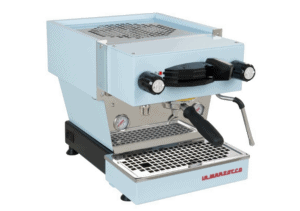

Even the GS3 MP at nearly 7k isn’t the most expensive machine you could go for, and if you felt like it, you could pair this with something like the Caedo E37Z grinder for a total setup worth almost eleven thousand pounds. Hey, someone has to win the Euro millions – it could be you, never say never.
So, home barista setups aren’t cheap, and for brand new, you’re talking a minimum of around £600.
If you’re one of the many people who want to get into the home barista thing on a budget – as I did – then one of the most obvious options is to buy a used espresso machine and grinder.
So with all that said, let’s get to it:
Kev’s Guide to Buying a Used Espresso Setup
I’m going to start off by talking about grinders, then I’ll get onto the espresso machines.
When it comes to grinders for a used home barista espresso machine and grinder setup, there are only a few options really.
First I’m going to talk about buying a used commercial coffee grinder. If you have a quick search on eBay for “commercial coffee grinder”, click on the “advanced search” link, and then look at “sold listings” you’ll see that lots of ex cafe grinders sell on eBay, and they occasionally go for bargain prices.
Buying a Used Commercial Coffee Grinder
The negative of going for a commercial grinder is that they’re usually not dainty things, although keep in mind that a lot of the bulk is usually the big bean hopper, and you don’t need that. It’s possible to mod at least some of the commercial grinders to make them single doser, which mean you don’t need the hopper at all.
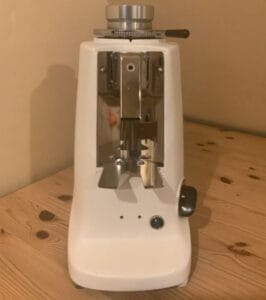
As well as Mazzer, you’ll find Macap, La Spaziale, Nuova Simonnelli, Ascaso, Fiorenzato, Ceado, Cunhill, Anfim & Compak grinders among others, on eBay as ex commercial use coffee grinders.
Not all commercial grinders are made equally at all, but most commercial grinders that would be in use in coffee shops are going to be easily good enough to use as part of a home barista setup, and in many cases better than spending the same money on a new grinder.
One of the most popular options is the Mazzer Super Jolly as mentioned above, you can often pick these up used from around £150. They’re a solid grinder, with flat 64mm burrs, made for heavy commercial use.
The problem for home use, is that these are usually the doser version. Many commercial grinders are doser grinders, so instead of grinding directly into the portafilter basket, you grind into the doser & then crank the doser paddle to dose the portafilter.
Doser grinders are overkill for home use, but it’s possible to mod commercial grinders to make them doserless, this is something commonly done with the Mazzer Super Jolly. You can also mod the super Jolly (and some other commercial grinders) to make them “single dose” grinders, which means you don’t need a hopper, as mentioned earlier.
This takes time, effort and cost. But what I’ve noticed is that you can actually pick up fully modded Super Jolly grinders from £250-£350.
In my humble opinion, a modded single dose, doserless Super Jolly is a great grinder to go for as the grinder part of your home barista setup.
Macap make very similar grinders Mazzer, and they’re cheaper – there are a few doserless models available too, and they’re quite common on eBay, so these are grinders to look out for.
What I’d recommend is that you keep an eye on eBay, buy and sell categories of forums, and other websites for used commercial grinders – and if you find one that you can get for a low price, just do some research, ask some questions on the forums, find out if it’s a good option.
Or if you want an easy life ;-), just set an alert on eBay for Mazzer Super Jolly, and just keep bidding until you get one at a great price, either already modded, or to mod yourself.
Used Home Barista Grinders
While there are loads of different makes and models of commercial grinders you’ll find coming up used, there aren’t as many options for lower cost home barista grinders.
I’d look out for the following:
- Eureka Mignon
- Baratza Sette
- Sage Dose Control Pro
- Sage Smart Grinder Pro
- Lelit Fred
- Iberital Mc2
The grinder that tends to come up the most often on eBay, is the Eureka Mignon – which I think is a great grinder, and I’d highly recommend if you can get one for a bargain.
There are various different versions, for more see:
Eureka Mignon Review
I used the Mignon Specialita for a while for review purposes, really impressed with it – solid little grinder, and great results for espresso – and you can get them from around £220 used, which I think is a bargain.
Baratza Sette 270 is another one to look out for on eBay, you’ll occasionally see this selling from around £220 and up, as with the Mignon Specialita.
The Sage Dose Control Pro & Smart Grinder Pro sell fairly regularly on eBay, but I think they sell at over the top prices quite often.
The smart grinder pro regularly sells for £160 – £170, which seems steep given the RRP is £199 for a brand new one with a 2 year warranty, and you can regularly get them on offer for less than this. The dose control pro is £159.99 at RRP, and this goes on eBay regularly for £120 used, which again seems over the top to me.
Given the price of the Sage grinders used, I’d go new – personally, and just wait until you can get one for a discounted price, as you can occaisonally. For more see:
Sage Smart Grinder Pro Review
The Iberital MC2 is a good performing espresso grinder for the price, but it’s a bit of a pain to use – a bit messy, and I’m not keen on the timer, I’d prefer an on demand grinder. For the price though, it’s worth putting up with for how capable it is for espresso, for a grinder costing under £130.
See:
Iberital MC2 Review
The Lelit Fred is essentially the same grinder as the MC2, but in a better quality shell, and on-demand instead of timer. It doesn’t come up often used, but you can get them for about £160 from Bella Barista.
For more on grinders see:
Best Coffee Grinders
Buying a Used Espresso Machine
At the entry level for home barista machines, we have the Gaggia Classic, Sage Bambino Plus & Sage Duo Temp Pro. These are all around four hundred quid, new.
There’s also the integrated grinder machines, the Sage Barista Express & Barista Pro – these are more money, but they include the grinder.
I’m going to talk about these machines shortly, before going further though, just to cover a very common quandary, Gaggia Vs Sage.
The most commonly asked question at the moment is specifically the Bambino Plus Vs Gaggia Classic Pro.
Watch my video above for more – but in a nutshell, the Bambino plus is big on user friendliness & beginner friendliness.
It pulls shots at 9 bars of pressure straight out of the box, it has a PID (temperature control) so it’s temperature stable. It’s ready in seconds, it’ll automatically steam your milk for you if you prefer that (and does a pretty good job of it too).
The Gaggia Classic Pro on the other hand, needs a bit of taming.
It comes at around 14 bar, so you need to mod it (cheap and quick) to drop the pressure to 9 bar (just a case of changing the over pressure valve spring).
Unless you fit a PID (for digital temp control) you’ll need to learn to temperature surf for consistent shots, so for the same kind of shot to shot consistency as the Bambino plus, you’ll need to fit a pid.
Overall though, with the pressure mod and either in the hands of someone who’s learned to surf it well – or with a PID – once paired with a decent grinder, in my humble opinion the good old Gaggia Classic is capable of a better quality shot.
Also – the Bambino plus is a modern kitchen appliance, with a 2 year warranty. If it breaks a few years down the line, you’re probably going to be scrapping it and replacing it.
The Gaggia classic is really simple inside, parts are readily available, you can fettle with a machine like this over the years and keep it going.
Mine is from 2003 and it’s still going strong, and they really hold their value used too, which I’ll get to shortly.
I love the Gaggia classic – I think it’s an amazing machine. I also love the Bambino Plus, I think that’s an amazing machine too – I have both.
Which you’d want to go for would just depend on you, if you consider yourself more of a hardcore home barista, someone who wants to tweak, fettle, take apart, put back together – and someone who is interested in shot quality above all: Gaggia Classic.
If on the other hand, you just want as good espresso as you can get with a fairly simple easy to learn routine, without taking up a hobby – and you value convenience and ease of use over an increase in shot quality (and you’re not even sure you’d have the palate to detect it): Sage Bambino Plus.
Gaggia Classic Pro Review Sage Bambino Plus Review
So with that common question out of the way, let’s talk for a minute about buying a used Gaggia Classic.
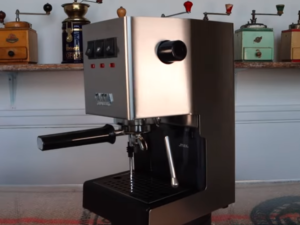

![]()
![]() The main thing to be aware of when buying a used classic, is there are various classics.
The main thing to be aware of when buying a used classic, is there are various classics.
Up until 2009 they were made in Italy, by Gaggia Milano – they featured the revered 3 way solenoid valve, the easily adjustable over pressure valve, and they were easy to mod the steam wand to a pro wand, by fitting a Rancilio Silvia wand.
After this, there were a few versions none of which were quite the same as the original, they had a solenoid valve but it wasn’t the same type, and they started using bits of plastic where there was previously metal, it just wasn’t quite the classic in several ways.
But 2015 (made from 2014 onwards) was the model that was the most removed from the original classic.
No 3 way solenoid, no traditional rocker switches, you can’t (or maybe you can but it’s a lot harder) mod the steam wand, and it didn’t go down particularly well.
Instead of the tiny high powered (1400W) 80ml Aluminium boiler, the 2015 model had a bigger 250ml stainless steel boiler with 1300W of power.
Instead of the much loved 3 way solenoid valve, the 2o15 version has a “mechanical valve.”
All of these things have seen the 2015 model getting some real hate from the hardcore Gaggia classic users community, but actually, I think they’re way better than their reputation would suggest, and they represent an opportunity to get hold of a decent espresso machine at a lower price.
In my opinion, most of the things about the 2015 model that have earned it the poor reputation (and importantly, the lower average selling price for used machines on eBay) make little or no difference to shot quality.
In fact, there have been side by side comparisons done with the 2015 and pre 2009 models which have either concluded that there’s almost no difference, or surprisingly that the 2015 model produces slightly better tasting shots with certain coffees.
In my humble opinion there’s only really one major negative thing about the newer version known as the 2015 classic, and that’s the push buttons – in particular, the shot button, which is known to stick.
Other than that, I think if you’re considering a used classic & you don’t want to pay silly money for a 12 year old machine or even older, these machines are worth considering.
The switch issue is the only thing that would put me off, but – Gaggia Direct have sent me a reconditioned 2015 machine, and Ade from shades of coffee is looking into a potential mod to swap out the push button for a traditional rocker. Gaggia Direct are allowing me to Mod this machine and give it away to one of my Patreon supporters.
They’ve sent me a new Gaggia Classic Pro, too, and they’re allowing me to mod and give away this machine. Also, I have my original pre-philips (2003) classic, so I have a plan.
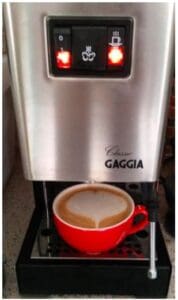
I’m going to create a YouTube video comparing these 3 machines against each other when it comes to shot quality. I’m going to blind taste test shots from all 3 classics, all un-modded, and the I’m going to mod the pressure on each machine & do another taste test.
Finally, I’m going to PID all three machines (fit a PID to tame the machines when it comes to temperature stability) and do the comparison again.
Then, hopefully I’m going to mod the 2015 machine to do away with the sticky push shot button & swap it for a traditional rocker switch.
If I find that the 2015 classic makes similar espresso to the pre-2009 classics, which I think is likely to happen, and if I conclude that the switch can be modded, then I’ll be suggesting that people thinking of a used classic begin to ignore the much more expensive pre-09 classics, and go for a better value for money 2015 machines and mod it by following my video instructions.
The new Gaggia classic pro, I think is great – and at four hundred quid brand new with a 3 year warranty (at the time of writing) it’s a very good option for a new machine, in my humble opinion.
So if you’re going to buy a machine out of warranty, I think it needs to be around a quarter of the RRP to offset the risks involved.
The older classic has such a high used value now, I don’t think it makes a great deal of sense to buy it.
If you’re happy to pay £200-£300 for a machine aged 12 years or older, I think you’d be well advised to spend £400 on a brand new machine, without the potential limescale, without the potential risk, with the warranty.
But the 2015 model is regularly available for around £80-£120, and at that price, I think it’s probably a risk worth taking – if the shot quality is likely to be similar, and if that annoying sticking switch issue can be rectified with a simple and inexpensive mod.
Also, the negative perception of the 2015 classic mainly comes from hardcore classic fans when comparing it to the original classic. The important question is, does the 2015 compare with the original classic when it comes to shot quality.
OK, so that’s the Gaggia Classic covered, for more on the classic see:
Gaggia Classic Pro ReviewGaggia Classic Old Model Review
Now let’s talk about the Sage machines.
I’ve mentioned the Bambino plus already, a very popular option, but its popularity means it hold its value well used, they end up selling for around £300-£325 most of the time, and for me that’s a bit daft, if you keep an eye out for offers you’ll probably get one new for that price at some point – I’ve seen them brand new quite a bit lower than that.
There’s the base level Bambino too – not the plus – which if it were available in the UK, would be of particular interest. It has most of the features of the plus, just without the auto steam option – and in the US it’s 299 dollars vs 499 for the plus.
I have a sneaking suspicion the base level Bambino will be available in the UK at some point though, and if/when this happens I think it’ll sell like hot cakes as an entry level home barista machine as long as we see a similar price difference as in the states.
This isn’t an option used in the UK as of yet as it’s not even available in the UK here yet, but I think it will be in the future.
There’s the Sage Duo Temp Pro, too – and while I wouldn’t recommend this new, I think it’s worth looking at used.
The only reason I wouldn’t recommend it new is that given it has the original slower heating and slower steam ready thermocoil vs the newer thermojet, I’d expect the price difference to be bigger, and new there’s very little difference in RRP.
Used though, you can find them from around £130 upwards – so potentially really good value for money.
Next, we have the Sage integrated grinder machines, the Sage Barista Express & Barista Pro – these are more money, but they include the grinder.
Sage Barista Express Review
I have reviewed the Barista Express, above, and I’ve actually got the Barista Pro right now – Sage have sent it me on loan to review, and in a nutshell, I love it! It doesn’t have the pressure gauge, which the Barista Express does, but it does have a shot timer, it has 30 grind settings, I think it’s a lot of machine for the money.
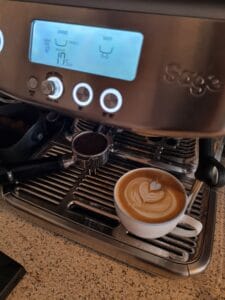
You can pick the Barista Express up used from around £300, and the Barista Pro from about £450. I’ve seen both models, used, going for very close to the RRP, so I’d say just don’t get sucked into bidding wars.
Also, keep in mind that the entry level Sage machines aren’t quite like the Gaggia machines that can be fettled with to keep them going for years. If you buy a Sage machine with no warranty, and it has a problem, you may be stuck with a machine you can’t fix.
The Sage Dual Boiler is a great machine, it’s £1,199.95 at RRP, and while you can regularly pick them up on eBay from around £450 – £500, if you’re lucky, I’ve seen the odd one (with no apparent issues) sell for as low as £200. If you can get a Sage dual boiler for this kind of price, you’re onto a winner!
The good thing about the Dual boiler, too, is that while you probably won’t find an independent espresso repairer who’ll deal with the likes of the Bambino plus, Barista Express or Barista Pro, many independent repairers will work with the dual boiler – so even if you’re unlucky, hopefully you’ll be able to find someone to sort it for you.
The Rancilio Silvia is another machine you’ll find on eBay, at quite a wide price range depending on the model and condition.
As with the Gaggia Classic, this is a bit of an unruly beast – but it can be tamed with a PID. With a PID fitted, the Silvia is a very popular home barista espresso machine.
Brand new this machine (without the PID) is just over £500 from Bella Barista, for version 6 (the current version at the time of writing).
You will regularly see version 4 and version 5 machines selling on eBay from around £300, and if you’re lucky you can get hold of these versions with a PID fitted from around £400.
Overall, I think a used Rancilio Silvia is definitely an option worth considering.
Lelit machines come up fairly regularly used, too – in particular at the lower end the Lelit Anna PL41TEM which you’ll find for around the £300 mark.
This is an interesting machine for the price, it’s very similar technically to the Rancilio Silvia, but it comes with a PID, and you can get it from around £300 used. Just make sure it’s the PL41TEM version, there are cheaper options without the PID and without a pro steam wand.
Nuova Simonelli Oscar 2 is another espresso worth keeping an eye out for used. They’re heat exchanger machines, around £800 new, and you can pick them up from around £400 used. It’s a lot of machine for that money in my humble opinion. If you can get an Oscar 2 for £400 and a Eureka Mignon for £200 – that’s a great home barista setup for £600!
Buying a Used Commercial Espresso Machine
Another option I just wanted to touch on before signing off, is buying a used commercial machine.
If you search eBay for espresso machines and select “Restaurant & Food Service” (instead of home appliances), you’ll find lots of ex cafe espresso machines. Most will be 2 group or 3 group, which are going to be far too big and bulky for most kitchens.
Even one group machines will be too big for most kitchens, but if you have the space for a commercial machine, it’s worth a thought. Just keep in mind commercial machines use a lot of electricity, depending on the size of the boiler(s), and you may need to get it plumbed in, although some can be tank fed or mains fed.
For example, this Wega Pegaso single group E61 machine went for just £360, reconditioned.
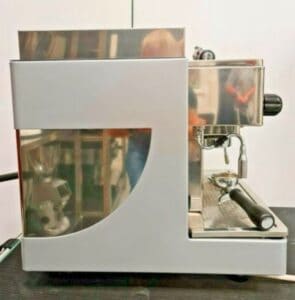

And this La Spaziale S1 Vivaldi II sold for £425.
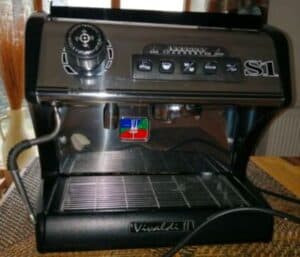

So there you go, my guide on buying a used home barista setup. I hope you find it helpful!
Life is like a box of chocolates, so join my Brew Time list, subscribe to my YouTube Channel, become an accredited coffee botherer (Patreon supporter), try my coffee at The Coffeeworks (use discount code coffeebotherers), follow me on Twitter & Instagram, follow the coffeeblog FaceBook page, and that’s all I have to say about that.
Spread the love
This article firstly appeared at Coffee Blog – The UK Specialty Coffee Blog – For Lovers of REAL Coffee!
This Article was mentioned on headmassage13.tumblr.com
This Article was mentioned on headmassage13.tumblr.com